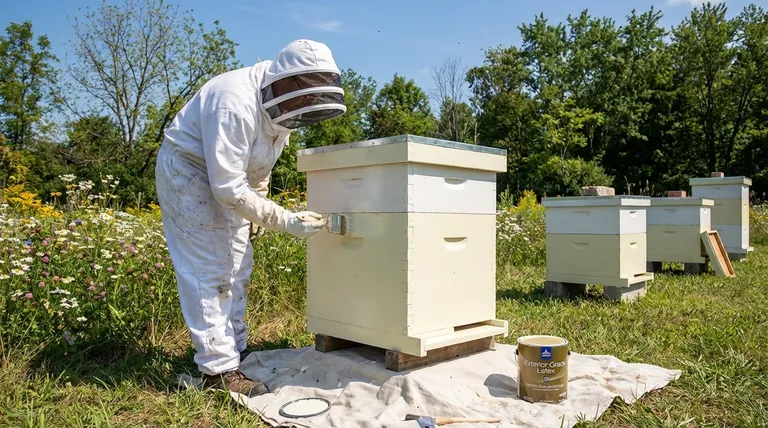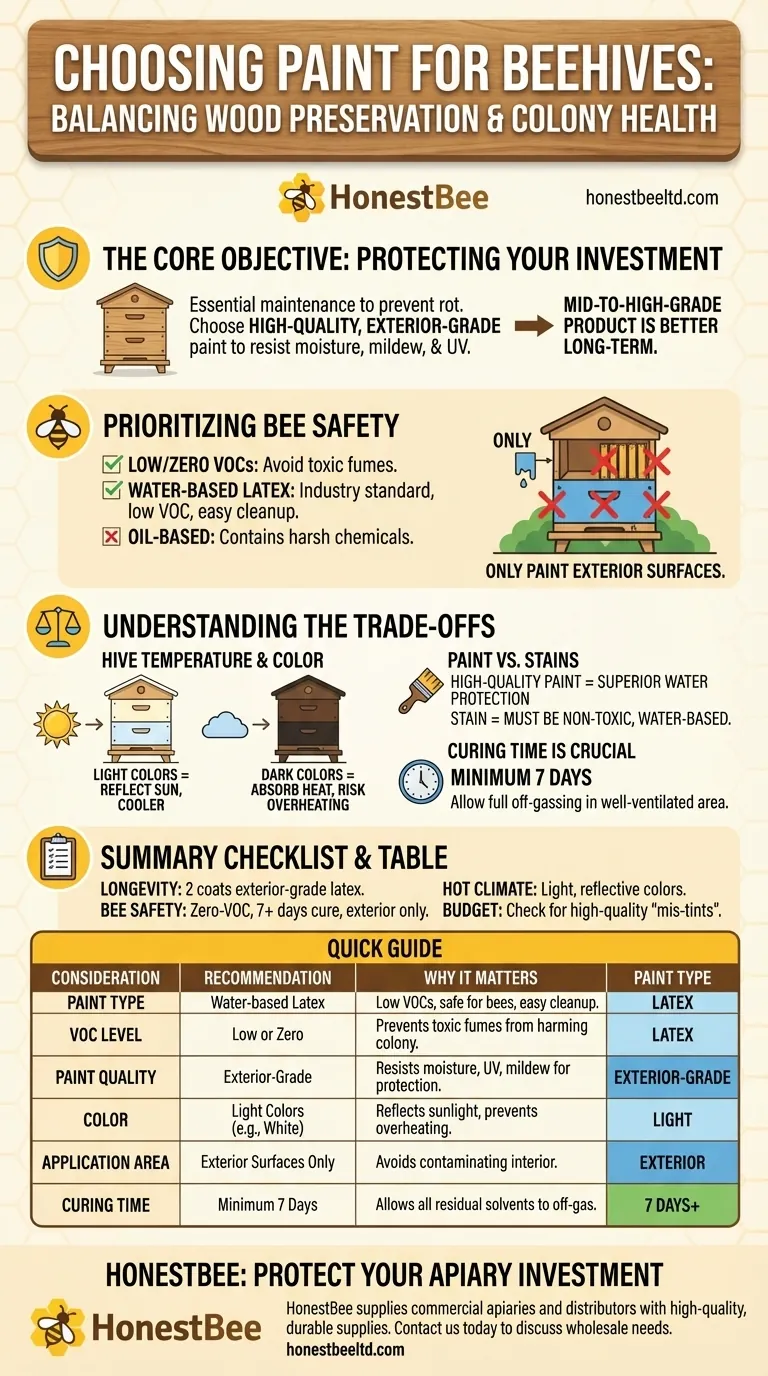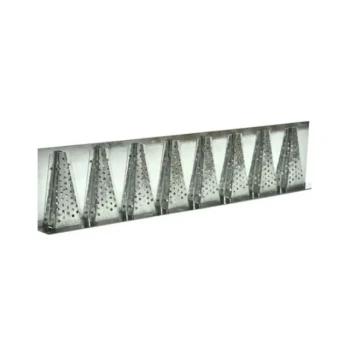Choosing the right paint for your beehive is a decision that balances wood preservation with the health of your colony. The best choice is a high-quality, exterior-grade, water-based latex paint with low or zero VOCs (Volatile Organic Compounds). This ensures the hive is protected from the elements without exposing the bees to harmful chemicals.
Your primary goal is not decoration, but creating a safe, durable shelter. The type of paint you choose and where you apply it has a direct impact on the hive's lifespan and the well-being of the bees inside.

The Core Objective: Protecting Your Investment
A wooden beehive is constantly exposed to rain, sun, and humidity. Painting is not optional; it is essential maintenance to prevent rot and decay, which can compromise the colony's home.
Why Exterior-Grade Paint is Essential
Exterior-grade paints are specifically formulated with additives to resist moisture, mildew, and UV degradation. Using interior paint or a low-quality alternative will lead to cracking and peeling, forcing you to repaint much sooner and offering less protection.
The Value of Quality
While it can be tempting to use cheap paint, a mid-to-high-grade product is a better long-term investment. These paints provide better coverage, often requiring fewer coats, and create a more durable finish that can last for years.
Prioritizing Bee Safety Above All
The most critical consideration is the health of your bees. The hive is an enclosed space, and any chemicals released from the paint can be concentrated and harmful.
The Danger of VOCs
Volatile Organic Compounds (VOCs) are solvents that are released into the air as paint dries. These fumes can be toxic to your bees. Always select a paint labeled as "Low-VOC" or "Zero-VOC" to ensure a safe interior environment for the colony.
Latex vs. Oil-Based: A Clear Winner
Water-based latex paint is the industry standard for beehives. It has naturally lower VOC content than oil-based paints, dries quickly, and allows for easy cleanup with just soap and water. Oil-based paints contain harsh chemical solvents and should be avoided.
What NOT to Paint
You must only paint the exterior surfaces of the hive boxes. Never paint any interior surfaces. The bees will manage the inside of their hive with propolis, a natural resin they produce.
Additionally, avoid painting areas of high bee traffic or contact, such as the landing board, entrance reducer, and the inner components like frames and foundation.
Understanding the Trade-offs
Making the best decision involves weighing a few key factors, from thermal regulation to drying time.
How Color Affects Hive Temperature
While bees do not have an aesthetic preference for color, your choice has a practical consequence. Lighter colors, like white, yellow, or light pastels, reflect sunlight and help keep the hive cooler in hot climates.
Darker colors absorb more solar energy. This can be a minor benefit in a very cold region but can cause the hive to dangerously overheat during the summer, forcing the bees to expend precious energy on cooling efforts.
Paint vs. Stains and Sealers
Some beekeepers consider using exterior stains. While this is an option, a high-quality paint typically offers superior water protection. If you do choose a stain, you must ensure it is a non-toxic, water-based formula that is safe for bees.
The Importance of Curing Time
"Dry to the touch" is not the same as fully cured. Paint needs time for all the residual VOCs and solvents to off-gas. You must let the painted hive components cure in a well-ventilated area (like a garage or shed) for at least 7 days before assembling the hive or introducing bees.
Final Checklist for Painting Your Hive
Your final choice depends on balancing these factors against your specific goals and environment.
- If your primary focus is hive longevity: Use two full coats of a premium, exterior-grade latex paint to maximize weather protection.
- If your primary focus is bee safety: Choose a zero-VOC paint and apply it only to exterior surfaces, allowing it to fully cure for a week or more before use.
- If you live in a hot climate: Select a light, reflective color like white or light yellow to help keep the colony from overheating in the summer.
- If you are on a tight budget: Visit a paint store and ask for their "mis-tints." You can often get a gallon of high-quality exterior latex paint for a steep discount.
A well-painted hive is a long-lasting, healthy, and productive home for your bees.
Summary Table:
| Consideration | Recommendation | Why It Matters |
|---|---|---|
| Paint Type | Water-based Latex | Low VOCs, safe for bees, easy cleanup. |
| VOC Level | Low or Zero | Prevents toxic fumes from harming the colony. |
| Paint Quality | Exterior-Grade | Resists moisture, UV rays, and mildew for long-lasting protection. |
| Color | Light Colors (e.g., White) | Reflects sunlight, prevents hive overheating in warm climates. |
| Application Area | Exterior Surfaces Only | Avoids contaminating the hive interior where bees live and work. |
| Curing Time | Minimum 7 Days | Allows all residual solvents to off-gas completely before bee introduction. |
Protect Your Apiary Investment with the Right Supplies
Choosing the correct paint is just one part of maintaining a healthy, productive apiary. HONESTBEE supplies commercial apiaries and beekeeping equipment distributors with the high-quality, durable supplies needed for success.
We understand the balance between equipment longevity and colony health. Let us help you equip your operation with everything from protective gear to essential hive components.
Ready to stock up on reliable beekeeping supplies? Contact HONESTBEE today to discuss your wholesale needs and ensure your apiary is built to last.
Visual Guide

Related Products
- Wholesales Dadant Size Wooden Bee Hives for Beekeeping
- Professional Insulated Plastic Bee Hives
- Long Langstroth Style Horizontal Top Bar Hive for Wholesale
- Inner Beehive Cover for Beekeeping Bee Hive Inner Cover
- Automatic Honey Flow Beehive 4 Frame Mini Hive for Beekeeping
People Also Ask
- What are the characteristics of oil-based paint for beehives? Durability vs. Modern Practicality
- What should you do if you find an ant nest near your beehive? Essential Strategies for Hive Protection
- What types of products are available for beekeeping needs? Essential Equipment for Apiaries & Distributors
- What should beginners consider when purchasing beekeeping equipment? A Guide to Essential Starter Gear
- What are the essential pieces of equipment for most beekeepers? Get Started with the Right Gear



















